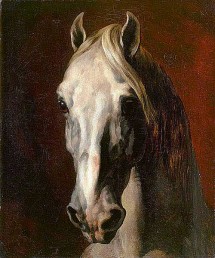The Life of Elves (Muriel Barbery)

Horse or boar?
Although a book should not be judged by its cover, we at TVC assert that it can be judged by its title, at least prima facie, unless and until evidence to the contrary is provided. (TVC declined to read The Elegance of the Hedgehog because of our aversion to eye-catching, cutesy titles. How can a novel with such a title, more than 6 million sales and a plot concerning a wise concierge and a suicidal teen be anything but “young adult” pulp?)
The advance notices, however, about Muriel Barbery’s third novel, The Life of Elves were promising. It had a less try-hard title, good reviews and no sales at all yet. The story-line – girls with elf-blood fight in the battle between the alliance of good elves and humans against enemy elves – did threaten to stray into the dread genre of young adult novels masquerading as something a human adult can read. But we elected to give it a try. And we are glad we did.
Although the premise of the gifted children facing supernatural terror is hardly unique, Barbery’s story is singular, poetic and captivating. Dark, quicksilver foundling Maria grows up in a farm in Burgundy, developing powers which allow her to manipulate the nature of things. Blue-eyed, inscrutable Clara grows up in Abbruzzo, listening to the music of the mountains. Maria is found in conversation with a white horse, or is it a wild boar? Clara, a visionary musical marvel, is taken to Rome to be tutored in piano and magic under the guidance of “the Maestro”. She is able to “see” Maria and they collaborate in the battle which closes the story.
When the poetic prose is good, it is effective:-
“She took the Italian envelope in her left hand, and with her right she inserted the pointed tip and began slicing along the edge.
And everything exploded: the door flew open and there was Maria’s outline in the door against a background of stormwild countryside; and the rain, which had been falling hard for a good half an hour, was transformed into a such a powerful deluge that all anyone could hear was the pounding of the downpour in the farmyard…the water did not sink into the ground, but hurled itself against it with a violence that caused an entire expanse of land to thrum as if it were a gigantic drum, before returning to the sky in the shape of gorged smoking waterspouts resounding with the thunder of their impact. Maria stood a moment longer in the door amid the general stupefaction and the terrifying clatter of the waters. Then she closed the door, walked over to the old women and held out her hand to Angelé who without understanding what she was doing, placed the letter in Maria’s palm. The world spun on itself and all of a sudden everything was right way up again, the rain stopped, and in the return of silence the rabbit stew bubbling it its juice made everyone jump.”
But it is often incomprehensible. There is a lot of this sort of stuff :-
“An ethereal joining took place inside her. Her inner worlds reconfigured, their junctures absorbed in the birth of an organic wholeness dissolved from every layer of reality”
(There is much opening of hearts, lives exploding and ancient consciousnesses quivering.)
At times it is simply nonsense:-
“{Leonora Acciavatti]…continued to receive her guests in the same singular manner as in her own home; no one walked behind her through the galleries but rather were arranged employing a geometry that knew nothing of straight lines: you adapted to the rolling and swaying of her movements; similarly, you didn’t sit opposite her, you were seated around her according to geodesic coordinates which imprinted the contours of an invisible sphere upon the private space”
Long passages coil in and upon themselves, fragmentary and in sore need of an editor. There is a sense that the author is trying so hard to be “magical” and “fantastic” that she loses her way, lapsing into confusion and obscurity in the hope that it will read as mysterious. Whether this owes something to a combination of translation and a very successful author being given her own head, it does let this otherwise entertaining book down.
Amid the whirling, overheated writing, many of the characters (in particular the male peasants, the “grandmothers” and the two shape-shifting elves) are difficult to distinguish. It is helpful to copy the table of characters and keep it close at hand.
Barbery is at her best in the magnificent battle scene. although there are faults in the pacing.
In its supernatural passages, talking animals (sorry, elves), windowless pavilion and visions of another world, The Life of Elves evokes C S Lewis, John Crowley, Susanna Clarke and the film of “The Lovely Bones”. While a “young adult” reader may well enjoy this book it is a fantasy for adults and, while not profound, it is worthwhile “light” fiction.
If reading this on an e-reader, do ensure that the endnote reader is functioning as TVC’s was not. The Google translator insisted that mantendré siempre means “always keep”, leaving this reader wondering for some time why Maria should hang onto the swaddling cloth on which the words were embroidered. When the endnote reader was restored to health, it was revelatory to learn that in fact mantendré siempre it is “always maintain”, the motto of the good elves.
Ends are left loose and questions remain unanswered. Barbery is reputed to be working on the sequel now. TVC will probably read the sequel, but we will probably not read The Elegance of the Hedgehog or The Guernsey and Potato Peel Pie Society. Unless you can convince us otherwise.
Leave a comment...
While your email address is required to post a comment, it will NOT be published.


5 Comments